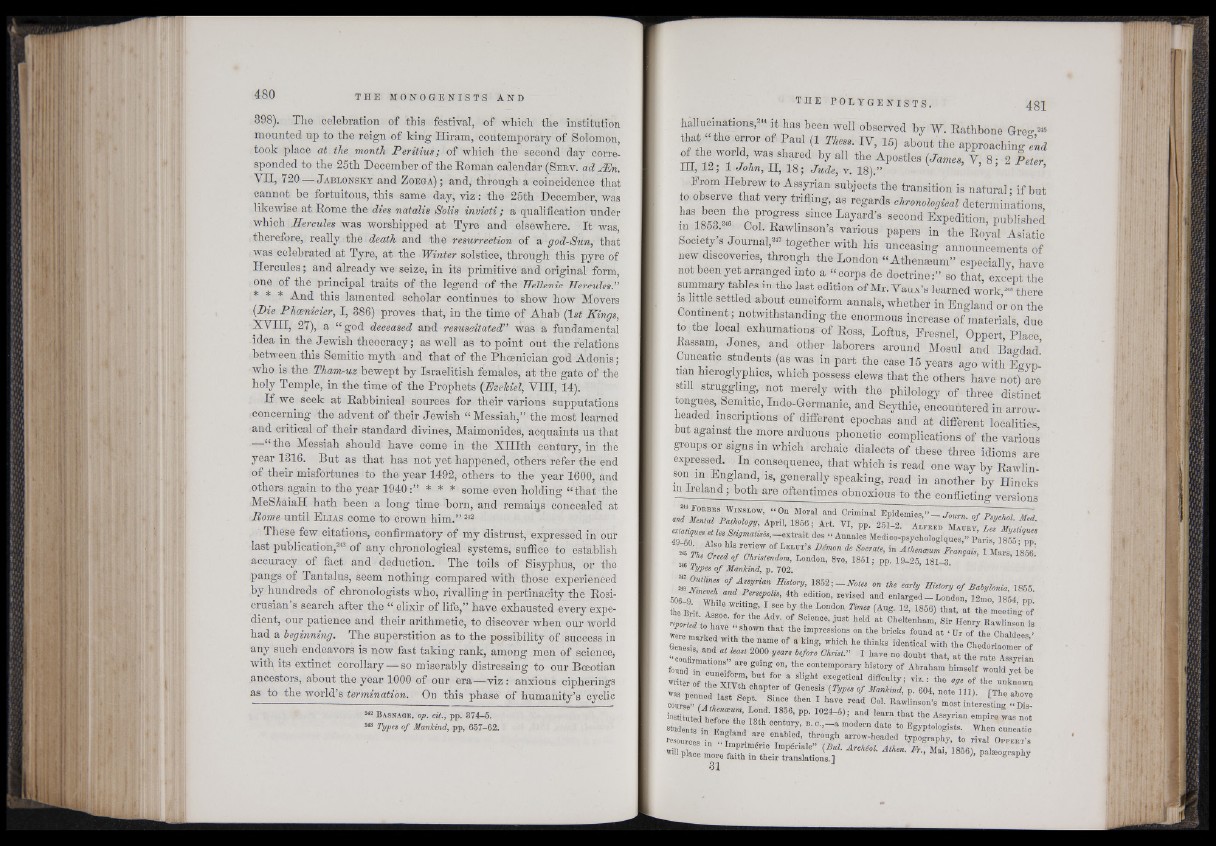
398). The celebration of this festival, of which the institution
mounted up to the reign of king Hiram, contemporary of Solomon,
took place at the month Peritius; of which the second day corresponded
to the 25th December of the Roman calendar (S e r v . ad JEn.
VH, 720 — Jablonsky and Zoega) ; and, through a coincidence that
cannot be fortuitous, this same day, v iz : the 25th December, was
likewise at Rome the dies natalis Solis invicti ; a qualification under
which Hercules was worshipped at Tyre and elsewhere. It was,
therefore, really the death and the resurrection of a god-Sun, that
was celebrated at Tyre, at the Winter solstice, through this pyre of
Hercules; and already we seize, in its primitive and original form,
one of the principal traits of the legend of the Hellenic Hercules."
* * * And this lamented scholar continues to show how Movers
{Die Phcenicier, I, 386) proves that, in the time of Ahab (1st Kings,
XVIH, 27), a “ god deceased and resuscitated” was a fundamental
idea in the Jewish theocracy; as well as to point out the relations
between .this Semitic myth and that of the Phoenician god Adonis;
who is the Tham-uz bewept by Israelitish females, at the gate of the
holy Temple, in the time of the Prophets (Ezekiel, YHI, 14).
If we seek at Rabbinical sources for their various supputations
concerning the advent of their Jewish “Messiah,” the most learned
and critical of their standard divines, Maimonides, acquaints us that
“ the Messiah should have come in the Xl I Ith century, in the
year 1316. But as that has not yet happened, others refer the end
of their misfortunes to the year 1492, others to the year 1600, and
others again to the year 1940:” * * * some even holding “ that the
MeSAaiall hath been a long time born, and remains concealed at
Borne until E l ia s come to crown him.” 242
These few citations, confirmatory of my distrust, expressed in our
last publication,243 of any chronological systems, suffice to establish
accuracy of fact and deduction. The toils of Sisyphus, or the
pangs of Tantalus, seem nothing compared with those experienced
by hundreds of chronologists who, rivalling in pertinacity the Bosi-
crusian s search after the “ elixir of life,” have exhausted every expedient,
our patience and their arithmetic, to discover when our world
had a beginning. The superstition as to the possibility of success in
any such endeavors is now fast taking rank, among men of science,
with its extinct corollary —■ so miserably distressing to our Boeotian
ancestors, about the year 1000 of our era—viz : anxious cipherings
as to the world’s termination. On this phase of humanity’s cyclic
242 Basnage, op. cit., pp. 374—5.
243 Types of Mankind, pp, 657—62.
hallucinations,244 it has been well observed by W. Rathbone Greg243
that “ the error of Paul (1 Thess. IV, 15) about the approaching end
of thworld was shared by all the Apostles {James, Y, 8; 2 Peter,
Hi, 12, 1 John, H, 18; Jude, v. 18).”
Erom Hebrew to Assyrian subjects the transition is natural; if but
to observe that very trifling, as regards chronological determinations,
Pro| ress Slnce Layard’s second Expedition, published
in 1853. Col. Rawlmson’s various papers in the Royal Asiatic
Society s Journal,247 together with his unceasing announcements of
new discoveries, through the London “Athemeum” especially, have
not been yet arranged into a “corps de doctrine:” so that, except the
summaiy tables m the last edition of Mr. Vaux’s learned work 248 there
is little settled about cuneiform annals, whether in England or on the
Continent; notwithstanding the enormous increase of materials, due
to the local exhumations" of Ross, Loftus, Eresnel, Oppert, Place,
Rassam, Jones, and other laborers around Mosul and Bagdad.
Cuneatic students (as was in part the case 15 years ago with Egyptian
hieroglyphics, which possess clews that the others have not) are
still struggling, not merely with the philology of three distinct
ongues, Semitic, Indo-Germamc, and Scythic, encountered in arrow-
headed inscriptions of different epochas and at different localities
but against the more arduous phonetic complications of the various
groups or signs in which archaic dialects of these three idioms are
expressed. In consequence, that which is read one way by Rawlin-
son in England, is, generally speaking, read in another by Hincks
mlreland; both are oftentimes obnoxious to the conflicting versions
246 Types of Mankind, p. 702.
“ S B ™ o r y of Babylonia, 1855.
606-9 m / f T ’ t °n’ IeViSed and enIarged-London, 12mo, 1854, pp
the Brit A « I N P I f 6 7 L°nd0U Tima (Ang‘ 12’ 1856) ttat> at ‘he meeting of
reported to h Z °e’ jUS* held a‘ Cheltenham, Sir Henry Rawlinson is
were „ , Sl)0wn lhat the repressions on the bricks found at I Ur of the Chaldees ’ '
Genes' a name °f * M° g’ Whioh h® thini:s ideiltical with the Chedorlaomer of
W h t “ ■> 2000 B I S H 1 W n° d°Ub‘ that> a‘ ‘he rate Z y r ia l
in cuTeif B S 1 9 V * M °°ntemporary history °f Graham himself would yet be
writer of the MVth’chalt r o § S B S 4116 £ 1 of the unknown
was 1 8 9 3 3 0/ Mankind’ P- 604’ n0te W i ^ h e above
course” " T n Z L 1 1 C°L l I S I “ ost interesting «M*.
S M W B m f l 18f 6’ PP' 102^ ); r d M i ‘he Assyrian empire was not
students in B f f i f S S tJ S i H t0 W M When cuneatic
resources in - l l J arrow-headed typography, to rival Ofpekt’s
■n p-.. l i f AMi ® ■■»). P i K J
31 J